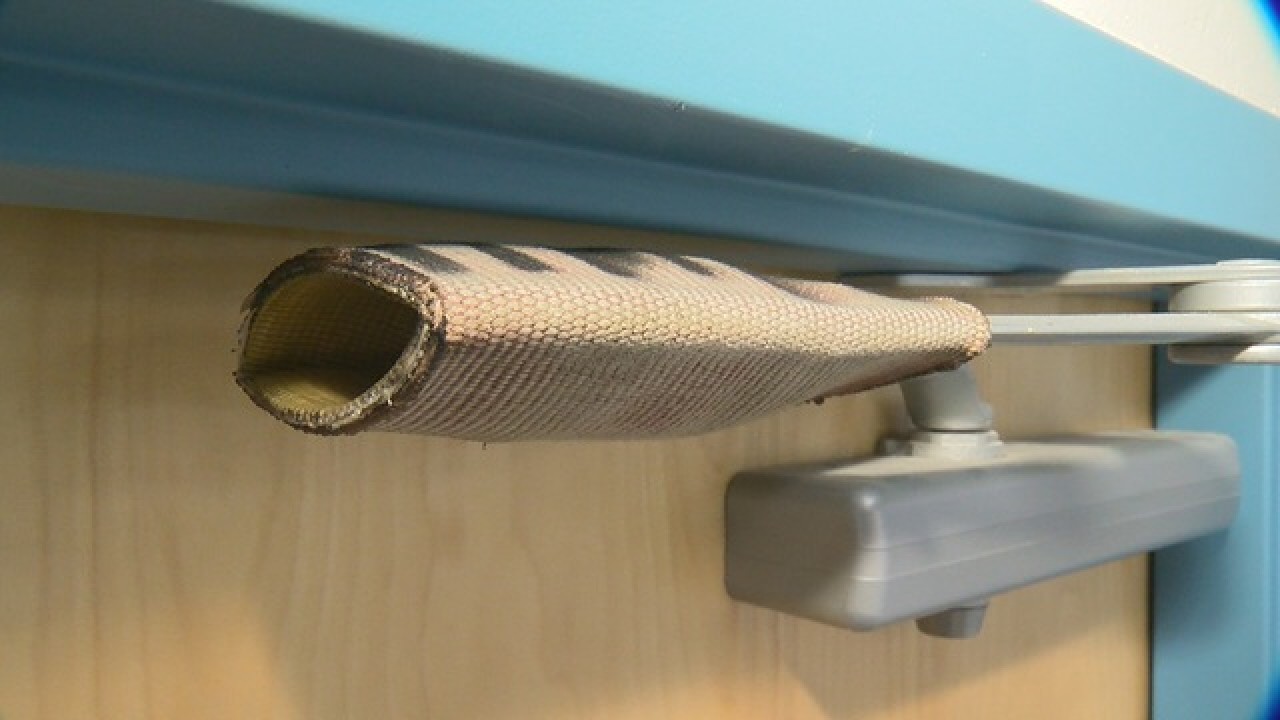A few months ago, a classroom barricade device manufacturer asked if I had any examples to support my claim that a barricade device could be used by an unauthorized person to lock a classroom door and commit a crime. I asked him whether he had any examples of a barricade device being used to prevent an active shooter from entering a classroom. To date, I don’t have a concrete example of either.
Unfortunately, we probably won’t hear about a barricade device being used – with negative OR positive effects – until there is a tragedy. As someone pointed out recently – why would anyone publicize the inappropriate use of something they have invested thousands of dollars in, that does not comply with current model codes and could increase their liability if it was used improperly?
Sometimes we can’t wait for concrete examples – we have to look at the potential risks and be proactive without going overboard. I probably won’t get into a car accident today, but I will wear my seat belt on my way to the grocery store. I won’t, however, go to Home Depot and buy materials to create my own 5-point safety harness because my seat belt might not be strong enough to prevent injury. Doing so might make me feel like I was more secure, but there would be no way to know if my homemade harness would offer more protection than the seat belt, and maybe it would jam and prevent my escape after an accident.
I know that school districts are trying to be proactive about security when selecting alternative locking methods for classroom doors. I am positive that everyone is working toward the common goal of keeping students and teachers safe. But let’s stop for a minute and think about the potential risks. This month, the National Center for Education Statistics (NCES) released its 2018 report on Indicators of School Crime and Safety, which contains school crime statistics for 2017. The FBI has published a report that lists active-shooter incidents in schools (and other facilities) for 2017.
Ask yourself these questions:
- According to the NCES, how many victimizations (theft and nonfatal violent victimizations) were experienced by students ages 12-18 in 2017?
- According to the FBI, how many active shooter incidents occurred in educational facilities in 2017?
Really think about these two numbers. How likely is it that non-code-compliant security methods might be used in a theft or nonfatal violent victimization (including rape, sexual assault, robbery, and aggravated assault)? And conversely, what are the chances that a barricade device will prevent an active shooter from entering a classroom? Many times when I’ve asked a friend to take a guess, they thought the number of active shooter incidents was much higher than it actually is, and they grossly underestimated the number of crimes that occur in schools.
Here are the answers:
The NCES report states that in 2017, it is estimated that students ages 12–18 experienced about 827,000 total victimizations (i.e., theft and nonfatal violent victimization) at school. According to the FBI, there were 4 active shooter incidents in educational facilities in 2017, with 3 fatalities and 9 injuries. Each and every one of those active shooter incidents is tragic, and even one casualty is too many. But almost 100% of schools will have one or more incidents of crime at some point, and far less than 1% of schools have experienced an active-shooter incident. We can not overlook the potential for misuse of non-code-compliant security.
 Here’s an example. I’m sure we have all heard about old fire hoses being cut up and donated to schools so they can be put on the door closer arm to prevent the door from being opened. I have so many concerns about this practice. In addition to possible misuse, how strong are these pieces of fire hose? Or is the closer arm the weak link? Or the screws attaching the closer shoe to the door? Do old fire hoses actually secure the door, or is it just a perception of security to make us all feel better (like my homemade safety harness)?
Here’s an example. I’m sure we have all heard about old fire hoses being cut up and donated to schools so they can be put on the door closer arm to prevent the door from being opened. I have so many concerns about this practice. In addition to possible misuse, how strong are these pieces of fire hose? Or is the closer arm the weak link? Or the screws attaching the closer shoe to the door? Do old fire hoses actually secure the door, or is it just a perception of security to make us all feel better (like my homemade safety harness)?
A couple of weeks ago I read an article about a lawsuit (hence the title of this blog post). A special education teacher in Washington state alleges that the building administrator in her school used a piece of fire hose on the door closer – which was mounted on the outside of the room – to confine her and a student within the classroom:
School employees struggled to contain the boy’s behavior, according to documents. He was known to try to run away from school and could also fly into rages and punch and kick staff. Maki wrote in the documents that the room was stripped of all unnecessary furnishings and equipment.
“I told my building administrator that I would not barricade myself in,” Maki wrote in notes from the time of the alleged incidents. “I further told her that I was uncomfortable with the plan and didn’t believe it to be safe or keeping with district policies,” Maki wrote. “My building administrator locked me in the room with the student using a modified fire hose which she slipped over the door hinge. This was done against my will.”
The door to the classroom was not locked, but instead a short length of fire hose was slipped over the hydraulic arm that prevents the door from slamming. The lengths of hoses were provided to schools as part of a safety plan. In case of an active shooter they could be used to prevent an intruder from entering classrooms. When installed they prevent the door from being fully opened. The door on the special education classroom opened into the hallway, however, so the hydraulic arm was on the outside.
It’s only a matter of time before we see the unintended consequences of non-code-compliant, untested, unregulated security devices. What keeps me awake at night is fear for the victims who will pay the price before we finally understand the cost of continuing to ignore the warnings.
Photo: KGUN 9
You need to login or register to bookmark/favorite this content.






I’m confused, door swings into the hallway and the closer is mounted on the hallway side. Who does that? Must have been the janitor!
I was a public school teacher at one time and as such I feel this is a very grievous situation that should have been addressed by her local and/or state teachers’ union, if any; perhaps it was and that information was not included in the article cited?
the APA study https://www.apa.org/education/k12/teacher-victimization
https://nces.ed.gov/pubs2004/2004004.pdf
Thanks John –
The 2018 NCES report says: The percentage of public school teachers reporting that they had been physically attacked by a student from their school in 2015–16 (6 percent) was higher than in all previous survey years (around 4 percent in each survey year) except in 2011–12, when the percentage was not measurably different from that in 2015–16 (Indicator 5).
It’s definitely a major concern!
– Lori
Thanks for the article Lori. I like your analogy about seat belts. We get pulled into conversations about evidence based solutions. Okay, let’s have that conversation. The evidence of which I am aware is:
– not one example of a barricade device being deployed to thwart an active shooter or other event of violence
– not one documented instance of an active shooter breaching a locked door
– 32 murdered and 23 injured at Virginia Tech when an active shooter barricaded himself in a classroom building that didn’t have any locks on the classroom doors
– Platte Canyon where an active shooter barricaded himself inside a room and murdered innocent students
Why do we keep having this conversation and playing whack-a-mole across this country? We have code compliant solutions that work. I hope it doesn’t take another tragic event to bring this conversation to a close.
Mark Williams, Vice Chair, Partner Alliance for Safer Schools
I agree completely, and the West Nickel Mines Amish Schoolhouse was another example where the gunman barricaded the door:
Washington Post: Police Share Lessons From Amish Shooting
NICKEL MINES, Pa. — From the moment a gunman began shooting 10 girls in an Amish schoolhouse last year, 2 1/2 agonizing minutes ticked by before state police were able to force their way into the barricaded building, according to newly revealed details about the siege…
http://www.washingtonpost.com/wp-dyn/content/article/2007/08/23/AR2007082300243.html
– Lori
I’m not a fan of any lock or device that violates “Free Egress” of door/window exits during potential emergency, which would also violate fire code. Our Community College has an ongoing discussion about Student, Faculty, and Staff safety, with many ideas and differences of opinions, up to and including armed security. When I study the case history of each of these tragic events occurring around our nation, it appears clear to me that the most common denominators are:
*Unwillingness of people to come forward-“See something, Say something.”
*Unwillingness or inability of those in leadership positions to address known or reported problems.
*Lack of sufficient resources to deal with known mental illness/instability issues.
Adequate access control methods along with effective security procedures are definitely necessary components to school safety, but hardware and software also need the vigilant human element to be successful, we must realize it is everybody’s job. And there must be a clear path established for reporting potential issues, with a real expectation that all will be taken seriously and addressed in a timely and appropriate manner.
Hi Gary –
Thank you for sharing your insight! I agree with you completely, but we are seeing so many school administrators and facility managers pressured to use unsafe security methods out of fear. We all need to keep clear heads and look at all sides of the problem.
– Lori
Lori, I represent the student who was locked in that classroom. He was so distraught that he peeled the rubber seal off of the door frame. The school district destroyed the video showing the student caught in the door when he tried to escape. Can you suggest someone able to describe how difficult it is to remove the rubber seal from around a typical metal door in a public school district?
Hi Kerri –
Do you know what type of seal was on the door? Like a product number or manufacturer? Or maybe a photo? Feel free to contact me directly at lori.greene@allegion.com.
– Lori
Lori, We couldn’t agree more! Well meaning people will attach any device on a classroom door without thinking of the consequences. We see it all the time. Active shooter incidents are rare, but a bully could live in the classroom 180 days a year. “Flip-type” locks, red button locks, and other barricade contraptions relinquish control of the door to a person potentially looking to do harm. We designed our product from the start to be “Bullyproof”, meaning that only the teacher or authorized person can maintain tactical control of a lockdown. Thank you for this article. We see these non-compliant devices being installed all over the country only to be told by a fire marshal that they need to be removed. – Sal Emma, CEO Defcon Products, LLC. http://www.teacherlock.com